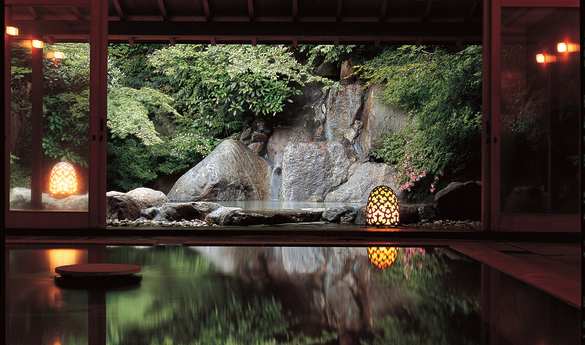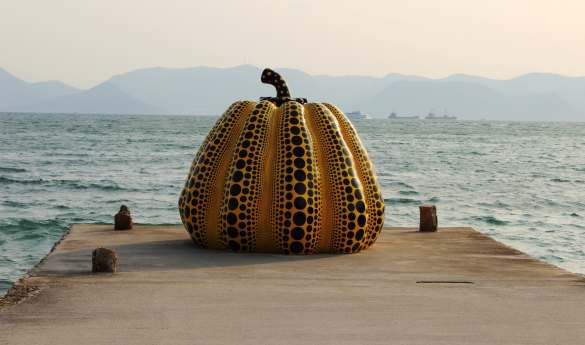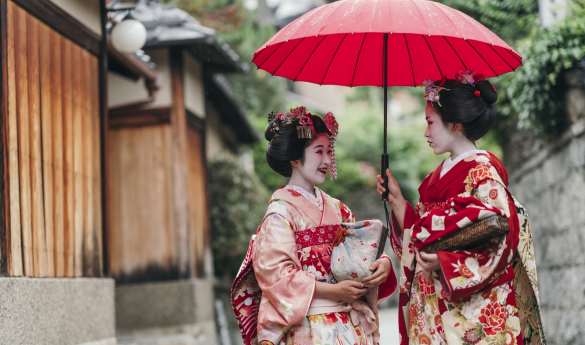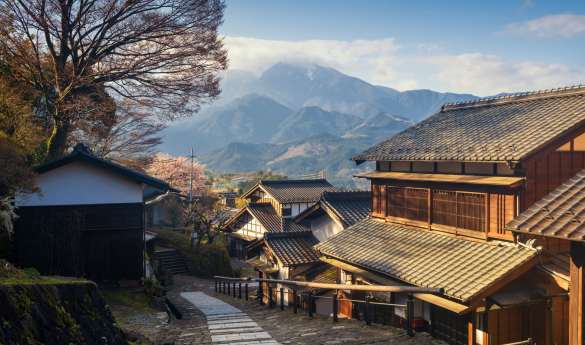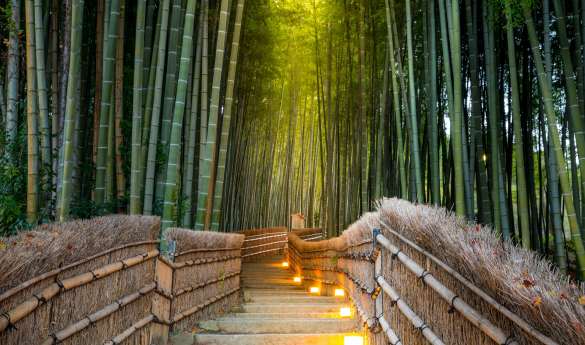Your Guide to Japanese Art
Whether it’s museum hopping on a bicycle on Naoshima art island or admiring the ancient pottery of long-lost treasures, Japan has so much to offer with its very own unique artistic expressions.

The Origins of Japanese Art
With an extensive history spanning over 12,000 years, Japanese artwork has evolved significantly to produce its very own unique and distinctive versions of creativity and expression.
The earliest inhabitants of Japan likely arrived from mainland Asia thousands of years ago. Because of this, Japanese art has a long history of Chinese influences. Its remarkable diversity can be seen across each historical period which proudly features unique characteristics and distinctive forms of art - namely during the following periods:
- Jomon
- Yayoi
- Kofun
- Asuka
- Nara
- Heian
- Kamakura
- Muromachi
- Azuchi-Momoyama
- Edo
- Meiji
- Taisho
- Showa
- Heisei
Over the years, the Japanese have absorbed and assimilated elements of foreign culture that complement their aesthetic artwork - blending yesterday’s charm and present-day modernity in perfect harmony.
Today, art in Japan features a wide range of styles and means of expression that leave visitors in awe and inspired.

What kind of art does Japan have?
From ancient Japanese art to modern, contemporary expressions, Japanese art has gone through many stages of evolution that define its present-day art form. Today, it covers a broad spectrum of creative expressions that include:
- Origami
- Painting
- Woodblock prints
- Literature
- Pottery
- Calligraphy
- Sculpture
- Architecture
- Manga
Architecture
Japanese architecture is distinctive. Seen in the use of materials and functions of its buildings – there’s a love for natural materials and the seamless harmonious interaction between the interior and exterior.
The most important buildings in the early days were shrines, built of wood and often adorned with beautiful, well-manicured gardens. Castles began to emerge in the Azuchi-Momoyama period (17th century) - built in the style of the shrines, featuring wooden powers and outcropping roofs. Housing feudal lords and soldiers, these castles retained the elegance of the shrines that they were based upon.
Representing modern Japanese art is its urban architecture. After going through several evolutions of innovation over its rich history, Japanese architects have brought to life some truly unique and iconic buildings of metal and concrete like the Tokyo Metropolitan Government Building, done in a postmodern architectural style that awe tourists and locals alike.

Contemporary Art
The Japanese contemporary art scene is dynamic as it is diverse, giving birth to contemporary artists like Yayoi Kusama and Takashi Murakami who have become international household names.
While ancient Japanese art has garnered the attention of everyone globally, contemporary art in Japan takes the world by storm. Bold experimental movements have emerged throughout the country that makes for a renewed and lasting impression on Japan.
The Seto Inland Sea region is popularly known as the creative hub of contemporary art - a cluster of islands which are home to avant-garde art museums and Instagram-worthy outdoor installations. One of the famous islands is Naoshima Island - Japan’s premier art island. As you arrive, you’ll be greeted by the oversized colourful pumpkin sculptures on the seafront - a prelude to Naoshima art.
While on the island, don’t forget to visit The Chichu Art Museum, a unique modern art museum that’s built underground to keep the natural beautiful view of the Seto Inland sea. Literally meaning “art museum in the earth”, this avant-garde museum houses over five distinctive art galleries, which were designed by globally renowned Japanese architect - Tadao Ando. Built in 2004, this magnificent museum is a major tourist attraction, drawing people from all around the world to discover its concept of rethinking the relationship between nature and its people and the best of art in Japan, making it one of our must-visit locations.
Despite being underground, this art museum is designed to leverage natural light for the illumination of the artworks, allowing you to discover something different throughout the various viewing times during the day. While on Naoshima art island, take the opportunity to explore the many abandoned houses, temples and workshops that have been re-energised by artists into modern art installations. Or even better, stay in a hotel that doubles as an art museum.

Calligraphy
As one of the most celebrated and revered forms of artistic expression within Japanese culture, Japanese calligraphy is an art form that truly brings to life ancient Japanese art.
Calligraphy was first brought to Japan by China in the 6th century A.D. and after centuries of evolution, a style and technique unique to Japan was born. Known by the locals as Shodo, which means “the way of writing,” calligraphy has been practised by samurai, nobility, and ordinary people ever since.
Through a careful choreography of brush strokes, Japanese calligraphy takes decades to master and can fetch high value as paintings and other forms of Japanese art. As an important aspect of Japanese culture, it harmoniously fuses poetry, literature, and painting into one unique art form.

Kabuki
A classical, complex and fascinating storytelling style, Kabuki is one of the three most famous Japanese traditional theatre styles that originated in the Edo period at the beginning of the seventeenth century.
In the beginning, both men and women acted in Kabuki plays, but eventually, only male actors performed - a tradition that has remained until today. Kabuki actors perform in a monotone voice and traditional instruments accompany the performance. Depicting tales derived from regional myths and history, Kabuki features music, dance, and mime with elaborate costumes and sets - the perfect opportunity to experience ancient Japanese art. Kabuki’s unique style of make-up is easily recognisable even by those who are unfamiliar. Largely unchanged for centuries, many modern kabuki techniques still retain their original methods and performers are directly descended from historical actors.
The Kabuki stage isn’t any ordinary stage. It’s built with revolving stages and trapdoors through which the actors can appear and disappear. Some of the distinctive characteristics you’ll find in a Kabuki theatre include its music, costumes, stage devices and props as well as specific plays, language and acting styles.

Tea Ceremony
Another form of art in Japan is its tea ceremony. Steeped in history, the Japanese tea ceremony is a significant ceremonial way of preparing and drinking green tea, most usually in a traditional tea room with a tatami floor.
Beyond just drinking tea, it’s a ceremony for guests to take a break from the hectic lifestyle and fast pace of city life to enjoy the hospitality of the host in a calm and relaxing setting. Usually practised as a hobby, there are many places within Japan where you can experience an authentic Japanese tea ceremony. Our Japan travel experts will prepare an itinerary that’ll take you to some of the most beautiful Japanese tea ceremony destinations, including unique and lesser-known spots.
Enjoy your Japanese tea ceremony at a traditional garden, culture centre or even hotel with Kyoto and Uji being some of the best destinations to enjoy Japan’s rich tea culture.
Japan Art Tours
Want to discover all the must-visit art destinations around Japan? Get in touch with one of our travel consultants or browse one of our luxury Japan tours and be prepared to experience the best of Japanese art with a carefully curated itinerary, like that of our Exceptional Japan tour.
Call us on 020 8682 5060 to start planning your holiday
Why Scott Dunn?
Unique to You

- We listen to your travel goals and craft unique trips that are bespoke to you.
- We’re with you every step of your life’s travel journey, from honeymoons to family trips and beyond.
Seamless Service

- Global offices in the UK, US, and Singapore for 24/7 seamless service.
- We offer flexibility if your plans change so you can book with confidence and peace of mind.
Carefully Curated Collection

- We’ve curated an elevated collection of accommodation, experiences, and guides.
- Committed to fostering close global relationships to continue bringing you unique experiences.
Luxury in Every Sense

- We deliver a sense of luxury that matters most to you.
- Awarded Condé Nast Traveller’s Top Travel Specialists in the World 12 years in a row.

